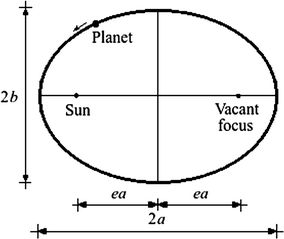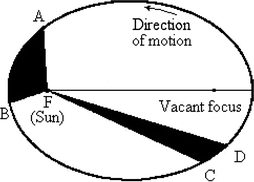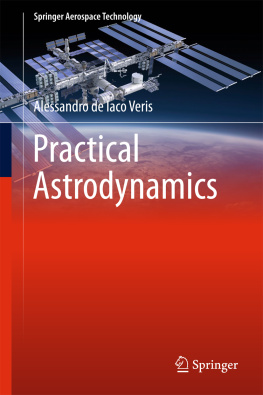Iaco Veris - Practical Astrodynamics
Here you can read online Iaco Veris - Practical Astrodynamics full text of the book (entire story) in english for free. Download pdf and epub, get meaning, cover and reviews about this ebook. City: Cham, year: 2018, publisher: Springer International Publishing, genre: Children. Description of the work, (preface) as well as reviews are available. Best literature library LitArk.com created for fans of good reading and offers a wide selection of genres:
Romance novel
Science fiction
Adventure
Detective
Science
History
Home and family
Prose
Art
Politics
Computer
Non-fiction
Religion
Business
Children
Humor
Choose a favorite category and find really read worthwhile books. Enjoy immersion in the world of imagination, feel the emotions of the characters or learn something new for yourself, make an fascinating discovery.
- Book:Practical Astrodynamics
- Author:
- Publisher:Springer International Publishing
- Genre:
- Year:2018
- City:Cham
- Rating:3 / 5
- Favourites:Add to favourites
- Your mark:
- 60
- 1
- 2
- 3
- 4
- 5
Practical Astrodynamics: summary, description and annotation
We offer to read an annotation, description, summary or preface (depends on what the author of the book "Practical Astrodynamics" wrote himself). If you haven't found the necessary information about the book — write in the comments, we will try to find it.
Practical Astrodynamics — read online for free the complete book (whole text) full work
Below is the text of the book, divided by pages. System saving the place of the last page read, allows you to conveniently read the book "Practical Astrodynamics" online for free, without having to search again every time where you left off. Put a bookmark, and you can go to the page where you finished reading at any time.
Font size:
Interval:
Bookmark:
- The orbits of the planets around the Sun are ellipses, with the Sun at one focus.

- The radius vector of each planet (i.e., the straight line segment drawn from the Sun to that planet) sweeps out equal areas in equal times, as the planet travels along its orbit.
 In the figure shown above, the time t AB taken by a planet to go from A to B is the same as the time t CD taken by the same planet to go from C to D, because the area of the sector FAB is equal to the area of the sector FCD. Thus, a planet moves fastest along its orbit when it is in the region about perihelion, and most slowly when it is near aphelion. For the sake of clearness, the figures given above show an ellipse having an eccentricity of about 0.68, which value is much higher than that of the orbit of any planet revolving around the Sun. The real eccentricities of the planetary orbits are generally small, as shown in the following table.Planetary eccentricitiesMercury0.205Jupiter0.049Venus0.007Saturn0.057Earth0.017Uranus0.046Mars0.094Neptune0.011Courtesy of NASA []
In the figure shown above, the time t AB taken by a planet to go from A to B is the same as the time t CD taken by the same planet to go from C to D, because the area of the sector FAB is equal to the area of the sector FCD. Thus, a planet moves fastest along its orbit when it is in the region about perihelion, and most slowly when it is near aphelion. For the sake of clearness, the figures given above show an ellipse having an eccentricity of about 0.68, which value is much higher than that of the orbit of any planet revolving around the Sun. The real eccentricities of the planetary orbits are generally small, as shown in the following table.Planetary eccentricitiesMercury0.205Jupiter0.049Venus0.007Saturn0.057Earth0.017Uranus0.046Mars0.094Neptune0.011Courtesy of NASA [] - The ratio of the squares of the periods T 1 and T 2 of revolution for two planets is equal to the ratio of the cubes of their respective major semi-axes a 1 and a 2, that is,


Mercury | 47.4 | Jupiter | 13.1 |
Venus | 35.0 | Saturn | 9.7 |
Earth | 29.8 | Uranus | 6.8 |
Mars | 24.1 | Neptune | 5.4 |
- Corpus omne perseverare in statu suo quiescendi vel movendi uniformiter in directum, nisi quatenus a viribus impressis cogitur statum illum mutare (Every body remains in its state of rest or of uniform motion in a straight line, unless it is compelled to change that state by forces impressed upon it). This law was originally enunciated by Galileo in 1638 [] in the following terms Inoltre, lecito aspettarsi che, qualunque grado di velocit si trovi in un mobile, gli sia per sua natura indelebilmente impresso, purch siano tolte le cause esterne di accelerazione o di ritardamento; il che accade soltanto nel piano orizzontale and is also known as the law of inertia.
- Mutationem motus proportionalem esse vi motrici impress, & fieri secundum lineam rectam qua vis illa imprimitur (The rate of change of momentum is proportional to the motive force impressed and is directed along the straight line in which that force is impressed), that is,where m is the mass of the body considered, and f and v are, respectively, the resultant of the forces applied to the body and its velocity vector. In case of constant mass, the preceding expression reduces to
 where a = d v /dt is the acceleration vector applied to the body.
where a = d v /dt is the acceleration vector applied to the body.
- Actioni contrariam semper & qualem esse reactionem: sive corporum duorum actiones in se mutuo semper esse quales & in partes contrarias dirigi (To every action there is always opposed an equal reaction, that is, the mutual actions exerted by two bodies are always equal and oppositely directed).
Font size:
Interval:
Bookmark:
Similar books «Practical Astrodynamics»
Look at similar books to Practical Astrodynamics. We have selected literature similar in name and meaning in the hope of providing readers with more options to find new, interesting, not yet read works.
Discussion, reviews of the book Practical Astrodynamics and just readers' own opinions. Leave your comments, write what you think about the work, its meaning or the main characters. Specify what exactly you liked and what you didn't like, and why you think so.










